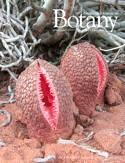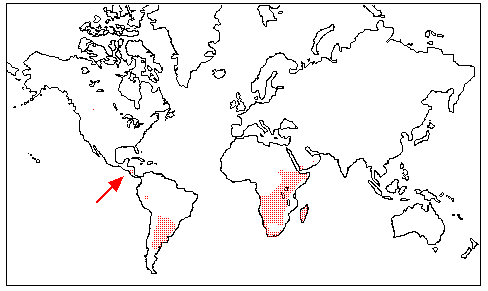 |
Hydnoraceae C. Agardh.
|
Distribution Map
Prosopanche is known from southern South America and Costa Rica. Hydnora
is found in Africa and Madagascar. This is a classic example of a
Gondwanan distribution. The ancestor of the two genera likely occupied
Gondwana prior to the separation of that continent into Africa and South
America ca. 100 million years ago. The amazing discovery of Prosopanche
in Central America (Gomez and Gomez 1981) demonstrates a wide range
disjunction for the genus. The taxon has been considered a new species (P.
costaricensis) or conspecific with P. americana of South
America.
Photographs
Hydnora abyssinica
- Comparison
of flowers (in longitudinal section) of H. abyssinica, H.
africana, and H. esculenta. Link
goes to ResearchGate.
- Photos,
flowers and other useful information. Photos by Ottmar Kullmer (African
Plants, A Photo Guide). Link goes to Useful
Tropical Plants.
- Photo
of a beautiful open flower. Photo by Jabruson. Link
goes to Minden Pictures.
Hydnora africana
- Habit on host plant, Euphorbia
mauritanica, near Worcester, South Africa. Photo by D. L.
Nickrent.
- Flower connected to horizontal
rhizome-like pilot root. Note the blackened and withered perianths
littering the soil nearby. Near Worcester, South Africa. Photo by D. L.
Nickrent.
- Close-up of 3-merous flower. Near
Worcester, South Africa. Photo by D. L. Nickrent.
- Day one flower (right) and
day two flower (left), showing "bait bodies" along edges of perianth
lobes. Karasburg District, Namibia. 29 December 2002, Photo by L. J.
Musselman.
- Pilot root (dark) showing
attachment by haustorial root to the root of the host plant (Euphorbia
- light colored). Near Worcester, South Africa. Photo by D. L. Nickrent.
- Young fruit forming from inferior
ovary of flower (left) and a flower bud (right) opened to show anther
attachment to perianth lobe. Near Worcester, South Africa. Photo by D.
L. Nickrent.
- Mature fruit, sectioned.
Karasburg District, Namibia. 28 December 2002 . Photo by L. J.
Musselman.
- Photos.
A series of excellent photos of the flower. South Africa. Photos by
Martin Heigan. Link goes to Flickr.
- Photos.
Photos of the flowers. Namaqualand, Northern Cape, South Africa. Photos
by Leon Olickers. Link goes to Flickr.
Hydnora esculenta
- Flower.
Berenty Private Reserve, Madagascar. Photo by Jay F. Bolin. Link
goes to ODU Plant Site.
- Flower. Photograph by Pete
Oxford (Minden Pictures), Berenty Private Reserve, Madagascar.
- Open
flower. From Berenty Private Reserve, Madagascar. Photo by Shirley
Sekarajasingham. Link goes to Flickr.
- Photos,
one showing the beetles that are involved in pollination. Link
goes to Useful Tropical Plants.
- Fruit with withered,
black perianth still attached at the top. Photograph by George Williams.
- Good photo of pilot root with
haustorial roots (bumps) along its length. Photograph by George
Williams.
- Fruit sectioned showing the
parietal placentae. The pulp and seeds of the fruit are sweet
andactively sought by lemurs.Photograph by George Williams.
- Fruit closeup showing the
seeds.Photograph by George Williams.
Hydnora johannis
- Flowers with ruler for
scale. Ethiopia: Harar Province. Photograph by William Burger [No.
3490], 9 May 1964. Slide no. 520. archived at Kew.
- A somewhat desiccated
specimen. Ethiopia: N of Midago. Photograph by William Burger
[s.n.], 9 May 1964. Slide no. 4173 archived at Kew.
- Flower, sectioned
longitudinally, with ruler. Ethiopia, N of Midago. Photo by William
Burger. 10 May, 1964. Slide no. 4174 archived at Kew.
- Top view of flowers emerging
from grassy area. Tanganyika: Kondoa District. Photograph by Roger
Polhill and Paolo [no. 1139], 11 Jan. 1962. Slide no. 1959 archived at
Kew.
- Flower being pollinated by an
orgy of beetles! From "Sex Lives of Flowers" by Meeuse, p. 92.
Photo by Malcolm J. Coe of Oxford Scientific Films.
- Fruit sectoned longitudinally.
Yemen. Photograph by Eric Danell.
Hydnora longicollis
- Flower L.S. comparisons
- left H. longicollis, middle H. africana, right H.
visseri. This species, formerly H. africana var. longicollis,
was recognized as a distinct species by Bolin et al. (2011. A new
species of Hydnora (Hydnoraceae) from southern Africa.
Systematic Botany 36:255-260).
- Illustration. Beautiful
drawing of the plant (from Welwitsch, F. 1869. Sertum Angolense ...
Trans. Linn. Soc. London 27, plate 21).
Hydnora triceps
- Flower. This species is almost
completely subterranean! Only the three small openings in the flower are
present near the surface of the ground.
- Flowers, longitudinally
sectioned.
- Fruits, showing various
stages of drying after being eaten by an unknown animal. Near Port
Nolloth, South Africa. 23 December 2002. Photo by L. J. Musselman.
- Fruits, beginning to
dehisce. Near Port Nolloth, South Africa. 23 December 2002. Photo by L.
J. Musselman.
- Fruit freshly cut fruit,
pericarp has not darkened. Near Port Nolloth, South Africa. 23 December
2002. Photo by L. J. Musselman.
- Fruit sectioned, close-up,
showing seeds. Near Port Nolloth, South Africa. 23 December 2002. Photo
by L. J. Musselman.
- Comparison of fruits of Hydnora
triceps (right) and H. africana (left), both immature.
Steinkopf Road a few kilometers east of Port Nolloth, Namibia. Photo by
L. J. Musselman.
Hydnora visseri
- Flower. This Namibian species
is a recent segregate of H. africana. See Bolin J. F., Maass E.,
Musselman L. J. 2011. A new species of Hydnora (Hydnoraceae)
from southern Africa. Systematic Botany 36:255-260.
Prosopanche americana
- A bud just emerging from the soil.
Near Cordoba, Argentina. Photo by Andrea Coccuci.
- The bud at an early stage of
opening. Only the top parts of the flower emerge from the soil - the
rest remain underground. Near Cordoba, Argentina. Photo by Andrea
Coccuci.
- Flower, fully open, showing the
dome-like, fused androecium. Near Cordoba, Argentina. Photo by Andrea
Coccuci.
- Flower, with androecium
releasing pollen, excavated to show the inferior ovary. Near Cordoba,
Argentina. Photo by Andrea Coccuci.
- Close-up of synandrium.
Lihue Calel, Argentina. 1996? Photo by J. Mauseth
- The strange flower is shown here
emerging from the soil in a field in Argentina. The plant is parasitic
on the roots of Prosopis, a tree in the legume family. Photo by
Lytton Musselman, Argentina.
- Fruit emerging from the
soil. Note the darkened remnants of the perianth at the apex of the
fruit and the circumscissile dehiscence. Photo by Lytton Musselman.
- Fruit excavated to show
circumscissile dehiscence. Photo by Lytton Musselman
- Pilot root with numerous
haustorial roots emerging from it. Those haustorial roots that have
broken off ooze white latex. Photo by Lytton Musselman.
- Prosopanche grows as far north as Bolivia and Peru. This
plant was found emerging from the soil in a garden (parasitic on Solanum)
in Santa Cruz, which occurs in the tropical part of Bolivia. Another
photo showing the a younger
open flower that was partially excavated. Photos May 2003 by Dr.
Pierre L. Ibisch.
- Prosopanche fruits, from the same Bolivian plants shown above.
This slide of a sectioned fruit
shows the white fleshy endocarp pulp surrounding numerous seeds. Cocucci
and Cocucci (1996) estimate 35,000 per fruit!). This
slide, shows a close-up of the pulp being visited by numerous
ants. Cocucci and Cocucci suggest that seed dispersal is endozoochorous,
probably involving nocturnal mammals (rodents, foxes, and armadillos).
Although ants clearly visit these fruits, it has not been documented
whether they effectively disperse the seeds. Photos July 2003 by Dr.
Pierre L. Ibisch.
- This Prosopanche occurs in
the Braulio Carrillo National Park near the Quebrada Gonzalez station,
500 m elevation, Costa Rica. The plant is parasitic on roots of rain
forest trees on the very wet Atlantic slope, quite different than the
habitat of the species growing in Argentina. Although named as a new
species (P. costaricensis L. D. Gómez & Gómez-Laur.), Coccuci
and Coccuci (1996) consider this name a synonym of P. americana.
Photo by B. Hammel.
- Photos
of plants called P. costaricensis. Costa Rica. Link
goes to Flora of the World.
- Prosopanche
flowers sectioned. Costa Rica, Limon, Pococi, P.N. Braulio
Carrillo; Llanura de Santa Clara. Barry Hammel, Paul & Hiltje Maas
(No. 18037). Link goes to TROPICOS image library
at MO.
Prosopanche bonacinae
- Flower attached to root.
Argentina. Photo by L. J. Musselman
- Flower of this species
compared to P. americana (right). Argentina. Photo by L. J.
Musselman
- Older flower, with perianth
dehiscing and fruit forming. Argentina. Photo by L. J. Musselman
- Young fruit. Argentina. Photo by
L. J. Musselman
- Root connected to host root
(smaller). Argentina. Photo by L. J. Musselman.
|
|
Bolin, J. F.,
E. Maass, and L. J. Musselman. 2009. Pollination biology of Hydnora
africana thunb. (Hydnoraceae) in Namibia: brood-site
mimicry with insect imprisonment. Int.
J.
Plant Sci.
170: 157–163.
|

|
Hydnora on the cover of
American Journal of Botany. See article by Tennakoon et al. on
the vegetative morphology and anatomy of H. triceps, a hypogeous
root holoparasite. AJB
2007, vol. 94, 1439-1449.
|
Phylogeny & Classification
This family contains two genera, Prosopanche
(S. and C. America), and Hydnora
(Africa and Madagascar). As with Balanophoraceae, Cronquist and Takhtajan
differed in their classifications of this family. Cronquist placed it in
Rosidae in Rafflesiales, Takhtajan in Magnoliidae with Rafflesianae.
Both were incorrect with regard to a relationship with
Rafflesiaceae. Takhtajan was closer in placing the family in
Magnoliidae, for indeed molecular data place Hydnoraceae in Piperales
(Nickrent et al. 2002, pdf HERE).
This was later confirmed by Naumann J, et al. (2013. Single-copy nuclear
genes place haustorial Hydnoraceae within Piperales and reveal a
Cretaceous origin of multiple parasitic angiosperm lineages. PLoS ONE
8:e79204).
The APG3 (2009) classification recognized five families in Piperales:
Aristolochiaceae, Hydnoraceae, Lactoridaceae, Piperaceae, and
Saururaceae. The Angiosperm Phylogeny Website by Peter Stevens shows
a tree with Hydnoraceae sister to Aristolochiaceae plus Lactoridaceae,
however, the text lumps these groups, recognizing subfamily
Hydnoroideae. In APG4 (2016), three families were recognized,
Saururaceae and Piperaceae, with Hydnoraceae and Lactoridaceae lumped into
Aristolochiaceae. The justification for the lumping derives from the work
of Naumann et al. (2013) who used 19 genes as well as Massoni et al.
(2014, Increased sampling of both genes and taxa improves resolution of
phylogenetic relationships within Magnoliidae, a large and early-diverging
clade of angiosperms. Molecular Phylogenetics and Evolution 70:84–93) who
used a 12 gene dataset. All of these molecular studies detected the same
six groups that correspond to the above five familes plus one other; a
part of Aristolochiaceae (subfamily Asaroideae) is distinct. It is worth
noting the the topologies of the Naumann and Massoni phylogenetic trees do
not agree with regard to the six groups, plus the introduction of
Hydnoraceae lowers bootstrap values at key nodes. It seems that instead of
lumping the shrubby Lactoridaceae (1 species, L. fernandeziana),
the morphologically bizarre holoparasite family Hydnoraceae, and
Aristolochiaceae (9 genera 465 species according to Mabberley 2008), it
would be simpler to simply elevate Asaroideae Burnett to the rank of
family and leave the rest of the classifications alone! This new family
(Asaraceae) would contain Asarum (ca. 80 spp.) and Saruma
(1 species, S. henryi). As I have argued (as have others), it is
important for members of our field to recognize the history of names when
considering re-classifications and to introduce the least
number of disruptions. For these reasons, I continue to recognize
Hydnoraceae as a distinct family in Piperales.
The most recent and comprehensive molecular phylogenetic study to examine
the above topic is the following:
Jost M, Samain M-S, Marques I, Graham SW, Wanke S. 2021. Discordant
phylogenomic placement of Hydnoraceae and Lactoridaceae within Piperales
using data from all three genomes. Frontiers in Plant Science
12:642598-642598. Available HERE)
That study "favored
recognition of four monophyletic and morphologically well circumscribed
families in the perianth-bearing Piperales: Aristolochiaceae, Asaraceae,
Hydnoraceae, and Lactoridaceae", in other words, exactly what I proposed
above. Despite being edited in September 2021, whoever authored the
Wikipedia page still insists on placing Hydnora and Prosopanche
in Hydnoroideae within Aristolochiaceae. As of January 2022, the Jost et
al. (2021) paper is not cited.

Last updated: 20 Jan-22 / dln





